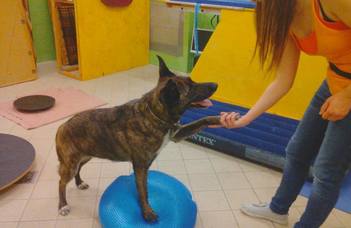Behavioural therapy against ageing

Ethologists at Eötvös Loránd University (ELTE) studied the effects of three months of cognitive, physical or combined therapy on elderly dogs, aged, on average, ten years. The results showed that each therapy had an effect on the dogs' behaviour. Physiotherapy made the dogs friendlier and more flexible, while mind games increased their novelty seeking. Improvements were more pronounced in the relatively younger, around eight years old individuals. As dogs age in a similar way to humans, the findings can help raise awareness about the importance of mitigating the effects of ageing from an earlier stage.
The ageing population, the increase in the number and proportion of older people, is one of the major challenges of our time, especially in Europe.
By 2050, it is projected that 30 out of 100 people will be over 65 and three of them will have dementia.
One of society's possible responses to this problem is to spread a culture of healthy living and to encourage as many people as possible to remain in good physical and mental health. An alternative or complement to medication is behavioural intervention, i.e. a therapy that seeks to improve mental function by changing behaviour, for example through physical exercise or crossword puzzles. Dogs can be a useful tool to help find out which intervention is most effective, as they age like humans but at a faster rate. In their latest study, researchers from the Department of Ethology at Eötvös Loránd University (ELTE) investigated whether physical or cognitive therapy or a combination of the two is most effective in improving cognitive performance in old age.
“According to the literature, a combination of physical and cognitive intervention therapies is the most effective for humans. Cognitive tasks direct which area should improve, while physical activity accelerates the progress. Cognitive therapies alone do not seem to be effective, as they only develop skills related to specific tasks. In this case, there is no so-called far-transfer effect, meaning that the positive impact does not appear in other, more distant abilities. For example, someone might improve at chess with practice, but that doesn't necessarily solve their spatial disorientation," explains Zsófia Bognár, one of the lead authors of a study published in the journal GeroScience.

So far, in dogs, mainly the effects of nutritional supplements have been studied, whereas studies on cognitive therapy are scarce, and physiotherapy has yet to be explored. To find out which therapy is the most effective, the researchers invited dog owners to participate in a twelve-week course, called the “Complex Experience Program”, and two behavioural tests at ELTE with their dog aged eight or older: one test before and one after the course. The aim was to see whether the course, or therapy, would improve the dogs’ performance in the test. A total of 109 dogs were registered for the course, but 25 failed the initial health screening.
"We only wanted to study healthy dogs because diseases affect the ageing process. We divided the applicants into four groups. For one group, dog trainers gave all kinds of mentally challenging tasks, including interactive games. In the second group, a physiotherapist led the training, for example, using inflatable tools to develop the dogs' balancing skills. The third group alternated between cognitive and physiotherapy sessions. The fourth group was the control, who did not attend any training between the two behavioural tests," says Dóra Szabó, the other lead author of the study.
The test, which measures cognitive performance, consisted of twelve tasks measuring, for example, memory, learning and problem-solving skills.
The results showed that dogs that received physical and combined therapy became friendlier and showed more behavioural flexibility. Cognitive and combined therapy increased the dogs' novelty seeking. All intervention therapies made dogs more engaged with their environment. Relatively younger dogs, around eight years old, improved more than older dogs, and those with lower baseline performance exhibited much better results after the therapy.
"Our initial question was whether combined therapy is more effective compared to cognitive or exercise-only therapies. The answer is no. However, we found positive effects with each of these therapies. It was particularly heart-warming to see how much the dog-owner pairs enjoyed these sessions. Many dogs really rejuvenated and this has brought great joy to the owner," says Enikő Kubinyi, head of the MTA-ELTE “Lendület” Momentum Companion Animal Research Group.
"He became more cheerful, happier, more open, more smiley, and more social; he's more willing to meet new dogs again." "Our relationship improved; he enjoyed the work and became fresher, more youthful." "He became more active, more curious, more motivated, and more energetic." "He loved the fitness sessions." These and similar feedback were received from owners.
Borbála Turcsán, the researcher handling the data, adds,
"Our results confirm that older dogs also need to work.
He may not win the district running race anymore, but keeping him active and exercising his mind can slow down his ageing and improve his well-being. Shared activities also strengthen the bond between dog and owner."
The researchers' findings show that even just one hour of playful therapy a week for three months can improve cognitive performance in older dogs. Of course, physical and brain exercise should be integrated into the daily routine. It's good not only for the dog but also for the owner, and the earlier they start, the stronger the effect will be.
Original article: Bognár, Z., Szabó, D., Turcsán, B., Kubinyi, E. (2024) The behavioural effect of short-term cognitive and physical intervention therapies in old dogs. GeroScience. https://doi.org/10.1007/s11357-024-01122-2
Related research:
Dogs Provide New Insights into Aging and Cognition

